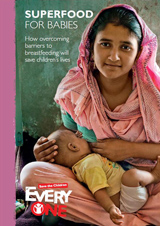
In the last two decades there has been huge global progress in reducing child mortality. Five million fewer children died in 2011 than in 1990. The world is nearing a tipping point, the time at which the eradication of preventable child deaths becomes a real possibility.
There is still a long way to go to achieve that goal. One-third of child deaths are still attributable to malnutrition; the reduction in malnutrition rates has been proceeding at a stubbornly slow pace. Unless
malnutrition is tackled it threatens to become the ‘Achilles’ heel’ of development, holding back progress in other areas. We must also tackle the unacceptably high number of newborn deaths: while overall child
mortality rates are falling, a larger proportion of deaths now occur within the first month of life.
Breastfeeding saves lives. It’s the closest thing there is to a ‘silver bullet’ in the fight against malnutrition and newborn deaths.
The Power of the First Hour
Breast milk is a superfood. In the first hours and days of her baby’s life the mother produces milk called colostrum, the most potent natural immune system booster known to science.1 Research for this report estimates that 830,000 newborn deaths could be prevented every year if all infants were given breast milk in the first hour of life.
It is not only through the ‘power of the first hour’ that breastfeeding is beneficial. If an infant is fed
only breast milk for the first six months they are protected against major childhood diseases. A child
who is not breastfed is 15 times more likely to die from pneumonia and 11 times more likely to die from diarrhoea. Around one in eight of the young lives lost each year could be prevented through breastfeeding, making it the most effective of all ways to prevent the diseases and malnutrition that can cause child deaths.
But breastfeeding is undervalued. This report finds that progress made in increasing breastfeeding rates in the 1980s (as a result of initiatives such as Baby-Friendly Hospitals and agreement on the International Code of Marketing of Breast-milk Substitutes) has stalled. Global rates of breastfeeding have remained below 40% for the past 20 years as breastfeeding has slipped down the list of political priorities. In some countries, particularly in east Asia and the Pacific, the number of breastfed children is starting to fall.
After years of neglect, malnutrition is starting to get the attention it deserves, with initiatives including the Scaling Up Nutrition (SUN) movement, the 1,000 Days Partnership and the G8’s New Alliance for
Food Security and Nutrition. The year 2013 will be crucial, with the UK hosting a ‘hunger summit’ as part of its G8 presidency. This gives a unique opportunity to address the question of child malnutrition,
including promoting the vital role of breastfeeding. In addition, Ireland is holding the European Union (EU) presidency, which will focus on nutrition, and SUN is gathering momentum in 33 countries across the world. It is vital that plans in each of these countries include protection, support and promotion of
breastfeeding. We must seize these opportunities to make a difference and accelerate progress towards the goal of ending preventable child deaths in our generation.